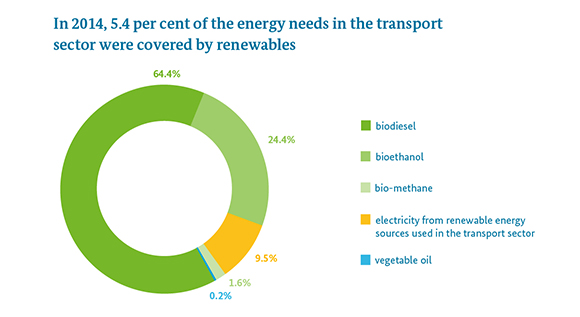What renewable technologies make Germany mobile?
From planes to freight trains and some 44 million cars: Around 28 per cent of energy in Germany is used for transport. That is roughly the same amount as is used by all the private households together. Renewables covered 5.4 per cent of the energy needs of the transport sector last year.
 The diagram shows the market shares of renewables in the transport sector in 2014. Overall, renewables cover 5.4 per cent of energy needs in this sector. © Data: ZSW from BAFA, AGEB; diagram: Federal Ministry for Economic Affairs and Energy (BMWi)
The diagram shows the market shares of renewables in the transport sector in 2014. Overall, renewables cover 5.4 per cent of energy needs in this sector. © Data: ZSW from BAFA, AGEB; diagram: Federal Ministry for Economic Affairs and Energy (BMWi)
As can be seen from the diagram, biodiesel has a share of approx. 64 per cent and is by far the most important "green" fuel. In comparison with 2013, sales of biodiesel actually rose by 3.5 per cent. Biodiesel is extracted from oil and fat, and particularly from rape seed oil, and can then be added to fossil diesel fuel.
The second-largest source of renewable energy in the transport sector is bioethanol, which can be manufactured via alcoholic fermentation from plants which contain starch, sugar or cellulose, such as maize, sugar beet and wood. For example, bioethanol is added to traditional "super"-grade gasoline, which is then sold as "E10" or "E85" at filling stations. The sales of bioethanol dropped by 3.3 per cent in 2014 compared with the year before.
In contrast, the significance of electricity from renewables in the transport sector has grown. There are two reasons for this: the number of electric vehicles has increased, as has the share of wind, sun and co. in the electricity mix. So more and more battery-driven vehicles can use electricity - which is increasingly deriving from renewable sources. The share of green electricity in total consumption of renewable energy in the transport sector rose from 8.8 to 9.5 per cent between 2013 and 2014.

